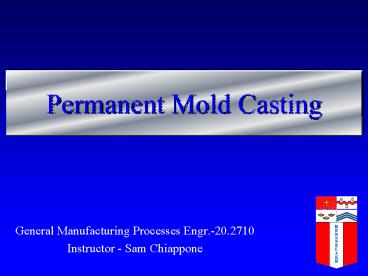Permanent Mold Casting PowerPoint PPT Presentation
1 / 18
Title: Permanent Mold Casting
1
Permanent Mold Casting
- General Manufacturing Processes Engr.-20.2710
- Instructor - Sam Chiappone
2
Multiple Use Mold
- Advantages
- Mold is reusable
- Generally, a good surface finish is obtained
- Dimensional accuracy can be as good as /- .003
- Control of mold temperatures
3
Multiple Use Mold
- Disadvantages
- Majority of molds use low-melt alloys
- Mold costs can be high
- Mold life varies
- Temperature of alloy being poured
- Mold material
- Mold temperature
- Thermal shock
- Mold configuration
4
Permanent Mold Casting (Gravity)
- The tool
- Molds are machined from tool steels and can have
metal retractable cores - The Process
- Molds are pre-heated
- Molten metal is poured into the molds and enters
the mold cavity through the gate under gravity
feed. After solidification.mold is opened and
part removed
5
Permanent Mold Casting
- Metals
- Aluminum, Zinc, Magnesium, Copper,and Brass
Alloys - Tolerances
- /- .012 first inch (add .002 per inch)
- Wall section .125
- Normal Minimum Section Thickness
- Aluminum.100" for small areas, up to 3/16" or
more for large areas. - Copper Base .060"
- Ferrous 3/16" for small areas, 1/4" normal.
6
Advantages
- Generally the same as all other multiple use
moldsand mold life is about 25,000 cycles
7
Disadvantages
- Some limitations in complexity of mold and fine
section detail may be limited
8
Pouring Process
Figure 13-19 Automatic pouring of molds on a
conveyor line. (Courtesy of Roberts Sinto
Corporation, Lansing, MI.)
9
Die Casting
- The Process
- Molten metal is forced into the die cavity under
pressure. The metal is kept under pressure until
it solidifies. Pressure ranges are 1,500 p.s.i.
to 25,000 p.s.i.
10
Process Steps
- Lubrication of dies
- Closing and locking of dies
- Molten metal is forced into the die cavity
- Held under pressure until it solidifies
- Die opens
- Casting is ejected
11
Process Parameters
- Normal Minimum Section Thickness
- Al .03" Small Parts .06" Medium Parts
- Mg .03" Small Parts .045" Medium Parts
- Zinc .025" Small Parts .040" Medium Parts
- Tolerances
- Al and Mg .002"/in.
- Zinc .0015"/in.
- Brass .005"/in.
- Metals Aluminum, Zinc, Magnesium, and Brass
12
Die Casting
13
Die Casting
Figure 13-4 Various types of die-casting dies.
(Courtesy of American Die Casting Institute,
Inc., Des Plaines, IL.)
14
Machines
- Hot Chamber
- 15 cycles per minute
- Direct transfer of molten metal into die cavity
- Used primarily with zinc and zinc alloys
- Cold Chamber
- Higher temperature alloys (aluminum and
magnesium) - Metal is melted in a separate furnace and
transported to the machine - Measured quantity of metal is forced into the
mold by a hydraulic or mechanical plunger (can be
a double plunger system for productivity)
15
Advantages
- Fine section detail (.003)
- Excellent dimensional accuracy (/- .002)
- High production rates
- Excellent surface finish
- Control of process temperatures
- Extended mold life
- Limited part defects
16
Disadvantages
- Part size (up to 75 lbs.)
- Limited to low melt alloys
- Initial tooling costs are high
17
Process Selection and Cost
- Each casting process has advantages and
disadvantages - Typical requirements
- Size, complexity, dimensional precision, surface
finish, quantity, rate of production - Costs for materials (dies, equipment, and metal)
Figure 13-20 Typical unit cost of castings
comparing sand casting and die casting. Note how
the large cost of a die-casting die diminishes as
it is spread over a larger quantity of parts.
18
Process Selection and Cost

